The Ballantine Adult Fantasy Series: The Spawn of Cthulhu edited by Lin Carter
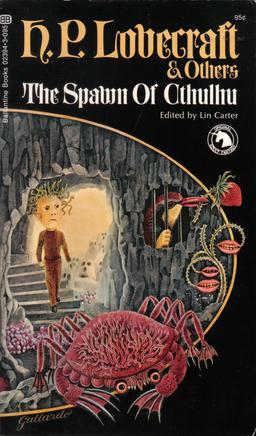 The Spawn of Cthulhu
The Spawn of Cthulhu
H. P. Lovecraft and Others
Lin Carter, ed.
Ballantine Books (274 pages, October 1971, $0.95)
Cover by Gervasio Gallardo
Lin Carter edited more than one anthology for the Ballantine Adult Fantasy series. Up until now, I’ve not discussed any of them. One reason is that where I am sequentially, there have only been two. The other reason is it’s easier to discuss a single novel than the contents of an anthology.
I’m going to break with that practice for this particular entry in the series. Carter has built a thematic Mythos anthology with The Spawn of Cthulhu. Taking references to the work of other writers referenced in Lovecraft’s short novel “The Whisperer in Darkness,” Carter then proceeds to include either the story referenced or other stories written about the Old Ones mentioned.
I’m going to include some mild spoilers in this post. If that is of concern to you, then let this paragraph serve as your warning. The discussion will start after on the other side of the Read More link just below.
Let’s start with “The Whisperer in Darkness,” shall we? It’s 85 pages long, by far the lengthiest story in the book. The story concerns a folklorist at Arkham University named Wilmarth who is writing a series of newspaper articles debunking sightings of strange bodies seen in swollen rivers and creeks after a particularly bad storm in Vermont. The articles generate some lively discussion in the paper, and are eventually reprinted in Vermont papers.
Wilmarth is contacted by an old farmer living in Vermont. The farmer’s name is Akeley, and his family has lived there for generations. He encourages Wilmarth to tone down his rhetoric in the newspapers. While Wilmarth initially considers Akeley to be a crank, the old farmer manages to convince the scholar that there may be something to these sightings. Over a period of months, he shares more and more evidence with Wilmarth that something is going on up in the remote hills of Vermont.
Akeley is convinced that the strange winged crabs that people have reported, and whose bodies were seen in the rivers after the storm, are from an undiscovered planet beyond Neptune, which Akeley refers to as Yuggoth. They are in the area mining some type of metal that they can’t get there. They have a very dim view of humans taking an interest in their affairs.
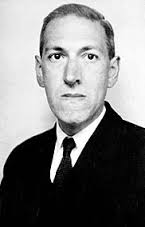
Wilmarth eventually goes to visit Akeley. Shortly before he does, Akeley’s tune changes. Instead of being a danger, the aliens are simply misunderstood. Wilmarth arrives at the isolated farm house late one night to discover Akeley sitting up in a chair in the darkened study. The old man claims he’s recovering from a respiratory ailment, promising to fill Wilmarth in on all the details the next day. He does take the time to show Wilmarth some cylinders. In the cylinders are the brains and nervous systems of members of other alien species. The members of the intergalactic community, of which the visitors from Yuggoth are but one representative species, travel this way. Akeley is planning on leaving for Yuggoth the next day and wants Wilmarth to accompany him.
Wilmarth slips out during the night and makes his escape, but not before making a horrible discovery. Where his friend had been sitting he finds the skin of the head and hands.
Lovecraft wrote the story in 1930, the year Clyde Tombaugh discovered Pluto. He set “The Whisperer in Darkness” in 1928. I’m sure the discovery of Pluto was a common topic of conversation, at least among those with an interest in science. I think his use of this interest makes for a stronger story, producing as it does an element of “I know something important that the narrator doesn’t know” in the mind of the reader.
In Part II of the “The Whisperer in Darkness” Wilmarth is reading a long letter from Akeley which accompanied some photographs the old man had taken. This is the quote that Carter uses to build the contents of the rest of the book:
I found myself faced by names and terms I had heard elsewhere in the most hideous of connections – Yuggoth, Great Cthulhu, Tsathogua, Yog-Sothoth, R’lyeh, Nyarlathotep, Azathoth, Hastur, Yian, Leng, the Lake of Hali, Bethmoora, the Yellow Sign, L’mur-Kathulos, Bran, and the Magnum Innominandum – and was drawn back through names aeons and inconceivable dimensions to worlds of elder, outer entity at which the crazed author of the Necromonicon had only guessed in the vaguest way.
Carter then proceeds to demonstrate the sources Lovecraft used to build his backstory and examples of how other authors joined him in his playground. Each story has a short introduction from Carter explaining how it fits in the Mythos.
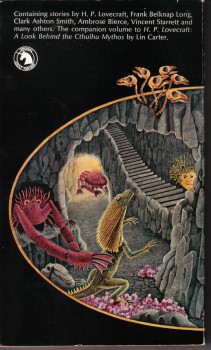
art by Gervasio Gallardo
The next story after “The Whisperer in Darkness” is Ambrose Bierce’s “An Inhabitant of Carcosa.” This is a short tale of an ill man whose ghost wakes up with no memory of his death centuries after the fall of his city, Carcosa. In addition to the city, a prophet named Hali is mentioned.
This story is followed by Robert W. Chambers’s “The Yellow Sign.” It’s from the linked short story collection The King in Yellow. Chambers borrowed Carcosa, Hali, and the god Hastur from Bierce. (Hastur appears in “Haita the Shepherd”, which is not included in The Spawn of Cthulhu.) This is a particularly horrific tale about an artist and his model/lover and a mysterious man who watches them from the church next door.
Vincent Starrett follows with a brief poem about The King in Yellow. The King in Yellow is, in Chambers’s tales, a play that when read can drive men mad.
In addition to preserving Lovecraft’s work in hardcovers after his death, August Derleth contributed a number of stories that expanded the Mythos. He’s represented here with “The Return of Hastur.” Told from the point of view of a doctor, it’s the tale of a son who disregards his father’s dying wish. Instead of destroying the house and its contents, he pursues his father’s studies. Much to his regret.
Lin Carter contributes some verse in “Litany to Hastur.”
Robert E. Howard is the next author represented. “The Children of the Night” combines his series character, the Pict Bran Mak Morn, and his minor series character, Kirowan, in a tale of reincarnation, racial memory, and revenge. I found it interesting to note in his introduction that Carter says that while contemporary sources cite five Mythos stories and one verse by Howard, he had found seven Mythos stories Howard wrote.
Walter C. Debill, Jr., provides the final poem, K’n-Yan.
Clark Asthon Smith is represented by “The Tale of Satampra Zeiros.” Here two Hyperborean thieves sneak into a deserted city and encounter more than they bargained for. This story marks the first appearance of Tsathogua.
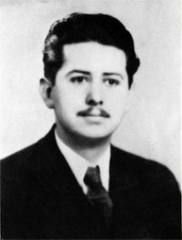
One of Lovecraft’s closest friends, Frank Belknap Long, introduces “The Hounds of Tindalos,” arguably the best of Long’s Mythos tales. The Hounds of Tindalos enter into the conversation Wilmarth has with Akelely when he visits the old man on his farm.
Another topic of their conversation is that of the snake god Yig. Zealia Bishop, a client of Lovecraft’s revision service, tells the story of a pioneer woman who offends Yig. This one has a particularly horrific ending, especially when you think about it.
The final story is from a man whose name is highly regarded today. But in 1971, Ramsey Campbell was an enthusiastic newcomer to the field. In his story, a man goes and visits “The Mines on Yuggoth.”
It’s in The Spawn of Cthulhu that we see Carter’s strength as an editor. His approach of including stories that are either referenced in “The Whisperer in Darkness” or reference it is an inspired one. I found all of the selections to be good, although the Campbell story didn’t really resonate with me. Many of the stories were familiar to me, including the Lovecraft, Chambers, Smith, and Long. Surprisingly, I don’t think I’ve read the Howard before.
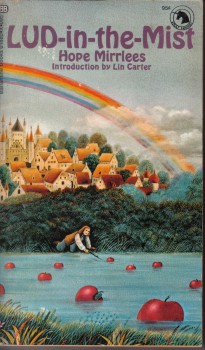 I enjoyed this anthology as much as I’ve enjoyed any of the BAF titles we’ve looked at so far and more than I’ve enjoyed many of them. It’s interesting to note that when this book was published in 1971, there wasn’t a great deal of new Mythos fiction being written. With the exception of the Carter and Campbell entries, all of the other stories were decades old (as near as I can tell), and the majority of the authors were dead. Today the Mythos is a cottage industry, and a thriving one at that. I don’t even try to keep up with how much new Mythos related fiction is published each year.
I enjoyed this anthology as much as I’ve enjoyed any of the BAF titles we’ve looked at so far and more than I’ve enjoyed many of them. It’s interesting to note that when this book was published in 1971, there wasn’t a great deal of new Mythos fiction being written. With the exception of the Carter and Campbell entries, all of the other stories were decades old (as near as I can tell), and the majority of the authors were dead. Today the Mythos is a cottage industry, and a thriving one at that. I don’t even try to keep up with how much new Mythos related fiction is published each year.
Cthulhu’s Spawn has produced Spawn of its own. Not only do I not try to keep up with all the new Mythos fiction published, I can’t keep up with all the new authors. If you’re a Mythos fan or a Lovecraft fan, you’re living in a golden age of Mythos fiction.
I’m going to go back to the sequence of publication I was following before I looked at two of the Lovecraft volumes. Next time, we’ll take a close look at Lud-in-the-Mist by Hope Mirlees.
Join me, won’t you?
Recent posts in this series are:
Lin Carter and the Ballantine Adult Fantasy Series
Lilith by George MacDonald
The Silver Stallion by James Branch Cabell
The Sorcerer’s Ship by Hannes Bok
Deryni Rising by Katherine Kurtz
Land of Unreason by Fletcher Pratt and L. Sprague de Camp
The Doom that Came to Sarnath by H. P. Lovecraft
Keith West blogs way more than any sane person should. His main blog is Adventures Fantastic, which focuses on fantasy and historic fiction.
Posted in Books, Reviews, Series Fantasy, Vintage Treasures
Another great overview of a fine collection.
Thanks, Joe H.
Great piece. “Whisperer” is one of my favorites. I guess I’ll have to reread it.
Thanks, Fletcher. I’ve always thought “Whisperer” was one of HPL’s best.
[…] Read Keith West’s detailed review here. […]
[…] My latest post on the Ballantine Adult Fantasy series at Black Gate is up. It’s over The Spawn of Chthulu, edited by Lin Carter. Here’s the link to it. […]
[…] the Rings” (March 1969); multiple short story anthologies such as Dragons, Elves, and Heroes and The Spawn of Cthulhu (1969-1972); many introductions to books in BAF the series; and most importantly, Imaginary Worlds: […]